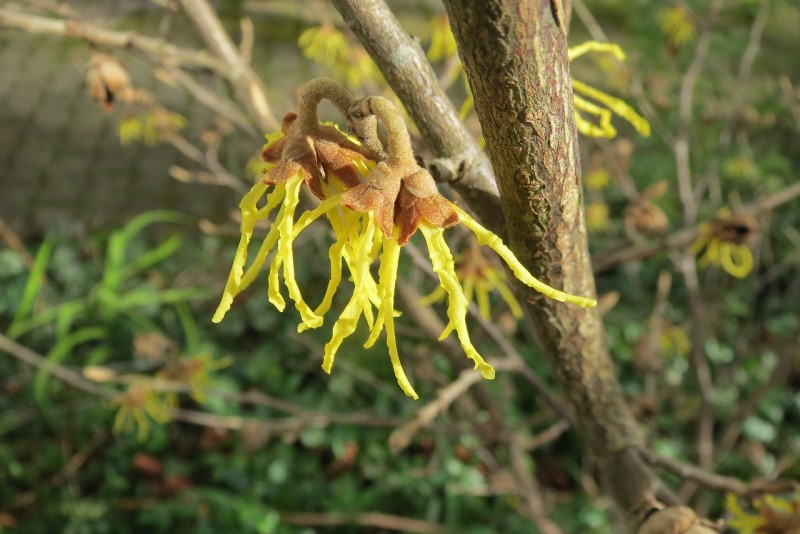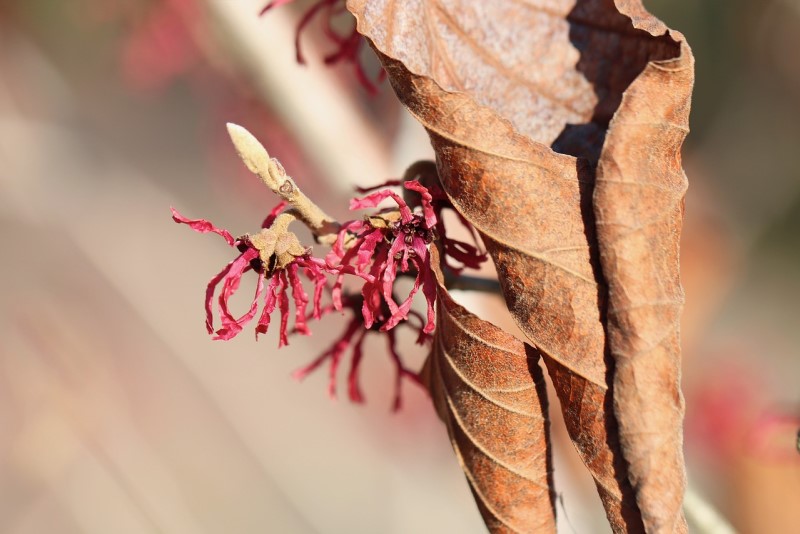
 Name: Hamamelis virginiana
Name: Hamamelis virginiana Family: Hamamelidaceae
Family: Hamamelidaceae Origins: Native to North America, particularly eastern United States and Canada
Origins: Native to North America, particularly eastern United States and Canada Humidity: Prefers moderate humidity levels
Humidity: Prefers moderate humidity levels Location: Can be grown in both full sun and partial shade
Location: Can be grown in both full sun and partial shade Soil: Well-draining soil, preferably acidic to slightly alkaline pH
Soil: Well-draining soil, preferably acidic to slightly alkaline pH Pests and diseases: Generally resistant to pests and diseases, but can occasionally be affected by aphids, scale insects, and leaf spot diseases
Pests and diseases: Generally resistant to pests and diseases, but can occasionally be affected by aphids, scale insects, and leaf spot diseases Care: Regular watering, especially during dry periods; pruning to maintain shape and remove dead or damaged branches; mulching to conserve moisture and suppress weeds; minimal fertilization
Care: Regular watering, especially during dry periods; pruning to maintain shape and remove dead or damaged branches; mulching to conserve moisture and suppress weeds; minimal fertilization Height of growth: Typically reaches a height of 15-25 feet (4.5-7.5 meters), but can occasionally grow taller under favorable conditions
Height of growth: Typically reaches a height of 15-25 feet (4.5-7.5 meters), but can occasionally grow taller under favorable conditions Planting in the soil: Best planted in early spring or fall, digging a hole slightly larger than the root ball and ensuring the top of the root ball is level with or slightly above the soil surface
Planting in the soil: Best planted in early spring or fall, digging a hole slightly larger than the root ball and ensuring the top of the root ball is level with or slightly above the soil surface Blooming: Blooms in late fall or early winter, producing fragrant, yellow flowers with strap-like petals
Blooming: Blooms in late fall or early winter, producing fragrant, yellow flowers with strap-like petalsHamamelis Virginiana, commonly known as witch hazel, is a plant species with significant importance in various ecosystems. This unique plant belongs to the Hamamelidaceae family and is native to North America. It has been recognized for its medicinal properties and its distinct characteristics.
Content:
- 1 Hamamelis Virginiana Anatomy
- 2 Hamamelis Virginiana Physiology
- 3 Hamamelis Virginiana Reproduction
- 4 Plant Growth and Development in Hamamelis Virginiana
- 5 Plant Adaptations of Hamamelis Virginiana
- 6 Plant Interactions of Hamamelis Virginiana
- 7 Economic Importance of Hamamelis Virginiana
- 8 Threats to Hamamelis Virginiana
- 9 Future Perspectives and Research on Hamamelis Virginiana
Hamamelis Virginiana Anatomy

A. Roots
Hamamelis Virginiana possesses a well-developed root system. It primarily consists of fibrous roots that spread horizontally in the soil. These roots anchor the plant and absorb water and nutrients from the surrounding environment.
B. Stems
The stems of Hamamelis Virginiana are woody and display a branching pattern. They provide structural support to the plant and serve as conduits for the transportation of water, nutrients, and sugars between the roots and the leaves.
C. Leaves
The leaves of Hamamelis Virginiana are alternate, simple, and possess a unique oval or obovate shape. They have wavy margins and are characterized by prominent veins. The leaves play a vital role in photosynthesis, capturing sunlight and converting it into energy for the plant’s growth and development.
D. Flowers
Hamamelis Virginiana produces fascinating flowers that are a highlight of this plant species. The flowers are typically small, with vibrant colors ranging from yellow to red. They are composed of four narrow petals and possess a unique fragrance. The flowers appear in late fall or winter, making Hamamelis Virginiana one of the few plants that bloom during that time.
Hamamelis Virginiana Physiology

Photosynthesis
Photosynthesis is a crucial process for Hamamelis Virginiana. Its leaves contain chlorophyll, which enables the plant to convert carbon dioxide and sunlight into oxygen and glucose. This energy-rich molecule fuels the plant’s growth and serves as a source of nourishment.
Respiration
Similar to other plants, Hamamelis Virginiana undergoes cellular respiration. It occurs in specialized structures within the plant’s cells, primarily in the mitochondria. Through respiration, the plant breaks down glucose to produce energy, facilitating various metabolic processes.
Transpiration
Transpiration is the process by which water is lost from the plant through its leaves. Hamamelis Virginiana participates in transpiration, allowing for the movement of water and essential nutrients from the roots to the upper parts of the plant. This process aids in the regulation of temperature, nutrient uptake, and the overall health of the plant.
Hamamelis Virginiana Reproduction
A. Sexual Reproduction
- Pollination Hamamelis Virginiana relies on cross-pollination for sexual reproduction. The flowers produce nectar and attract various insects, including bees, moths, and butterflies, which aid in the transfer of pollen between flowers.
- Fertilization Once pollination occurs, the pollen grains travel to the female reproductive organs of the flower, leading to fertilization. This process results in the formation of seeds within the flowers of Hamamelis Virginiana.
- Seed Formation Following fertilization, the seeds of Hamamelis Virginiana develop within the ovary of the flower. As the seeds mature, the flower undergoes changes and eventually disperses the seeds to propagate the species.
B. Asexual Reproduction
- Types of Asexual Reproduction Hamamelis Virginiana can also reproduce asexually through methods such as vegetative propagation. This process involves the development of new individuals from stems, leaves, or roots of the parent plant. Rhizomes, which are horizontal underground stems, can give rise to new shoots and roots, leading to the formation of genetically identical offspring.
- Advantages and Disadvantages Asexual reproduction in Hamamelis Virginiana offers certain advantages. It allows for rapid propagation and colonization of favorable habitats, ensuring the survival of the species. Additionally, since offspring are genetically identical to the parent plant, desirable traits can be preserved. However, a lack of genetic diversity can limit the ability to adapt to changing environmental conditions and increase susceptibility to diseases or pests.
Plant Growth and Development in Hamamelis Virginiana
A. Plant Hormones
- Types of Plant Hormones Hamamelis Virginiana exhibits responses to various plant hormones, including auxins, cytokinins, gibberellins, ethylene, and abscisic acid. These hormones regulate different aspects of growth and development, including cell elongation, root and shoot growth, flowering, and fruit ripening.
- Roles of Plant Hormones in Growth Plant hormones play a crucial role in coordinating the growth and development of Hamamelis Virginiana. They influence processes such as seed germination, stem elongation, leaf expansion, and the development of flowers and fruits. By interacting and signaling within the plant, hormones ensure proper growth, differentiation, and response to environmental cues.
B. Plant Tropisms
- Phototropism Hamamelis Virginiana exhibits phototropism, a growth response to light. The plant’s stems and branches tend to grow towards a light source, optimizing their exposure to sunlight for photosynthesis.
- Geotropism Geotropism, or gravitropism, is another tropism observed in Hamamelis Virginiana. It refers to the plant’s response to gravity, where the roots grow downwards, towards the gravitational pull, while the shoots grow upwards.
- Thigmotropism Hamamelis Virginiana may also display thigmotropism, a response to touch or mechanical stimuli. This phenomenon is observed when the plant’s tendrils or branches wrap around support structures, facilitating climbing or providing stability.
Plant Adaptations of Hamamelis Virginiana
A. Structural Adaptations
- Xerophytes Hamamelis Virginiana exhibits xerophytic adaptations, allowing it to thrive in dry or arid environments. These adaptations include deep root systems to access water, waxy cuticles on leaves to reduce water loss, and the ability to close stomata during periods of drought.
- Hydrophytes Although not exclusively a hydrophyte, Hamamelis Virginiana can tolerate wet or swampy conditions. It has adaptations such as air-filled tissues in roots and stems, which provide buoyancy, and the ability to withstand temporary flooding.
- Epiphytes While not commonly an epiphyte, Hamamelis Virginiana has adaptations that enable it to grow on other plants or structures without relying on soil for nutrients. This includes aerial roots that can absorb moisture and nutrients from the surrounding air or water.
B. Physiological Adaptations
- C4 and CAM Plants Hamamelis Virginiana does not exhibit C4 or CAM (Crassulacean Acid Metabolism) pathways, which are physiological adaptations seen in certain plants to maximize photosynthetic efficiency and reduce water loss in arid conditions.
- Halophytes Although not primarily a halophyte, Hamamelis Virginiana has some degree of salt tolerance, allowing it to survive in areas with moderate levels of soil salinity.
Plant Interactions of Hamamelis Virginiana
A. Symbiotic Relationships
- Mutualism Hamamelis Virginiana engages in mutualistic relationships with certain organisms. For example, it forms mutualistic associations with mycorrhizal fungi. These fungi colonize the roots of the plant, enhancing nutrient uptake in exchange for carbohydrates produced by the plant through photosynthesis.
- Commensalism Hamamelis Virginiana may also exhibit commensalistic relationships, where certain organisms benefit without harming or benefiting the plant directly. For instance, certain bird species may use the branches of Hamamelis Virginiana as perching sites or nesting locations, without causing any significant impact on the plant.
- Parasitism Parasitic relationships involving Hamamelis Virginiana are relatively rare. However, it may occasionally be affected by parasitic plants that derive nutrients from the host plant, leading to detrimental effects on its growth and development.
B. Plant-Animal Interactions
- Seed Dispersal Hamamelis Virginiana relies on animals for the dispersal of its seeds. Small mammals and birds consume the fleshy fruits, which contain the seeds, and later excrete them in different locations, aiding in the dispersal and colonization of new areas.
- Pollination Various insects, including bees, moths, and butterflies, play a crucial role in the pollination of Hamamelis Virginiana. As they visit the flowers to collect nectar, they inadvertently transfer pollen between flowers, enabling fertilization and seed production.
Economic Importance of Hamamelis Virginiana
A. Medicinal Uses
Hamamelis Virginiana has long been recognized for its medicinal properties. Extracts from its bark, leaves, and twigs are commonly used in traditional medicine and herbal remedies. They are known for their astringent, anti-inflammatory, and wound-healing properties, and are used in products such as creams, ointments, and toners.
B. Horticultural Use
Hamamelis Virginiana is popular in horticulture due to its attractive flowers, colorful fall foliage, and overall ornamental value. It is cultivated in gardens and parks for its aesthetic appeal and serves as a focal point in landscaping designs.
C. Environmental Benefits
Hamamelis Virginiana contributes to ecosystem stability by providing habitat and food sources for various organisms. Its presence in natural areas supports biodiversity and enhances ecological balance.
Threats to Hamamelis Virginiana
A. Habitat Loss and Deforestation
The conversion of natural habitats for agriculture, urbanization, or other human activities poses a significant threat to the survival of Hamamelis Virginiana. Deforestation disrupts the plant’s natural ecosystem and can lead to the loss of genetic diversity and overall decline in population size.
B. Invasive Species
The establishment of invasive plant species can negatively impact Hamamelis Virginiana by outcompeting it for resources, altering habitat conditions, and reducing its overall abundance.
Future Perspectives and Research on Hamamelis Virginiana
A. Conservation and Management
Efforts are needed to conserve the natural habitats of Hamamelis Virginiana, protect existing populations, and promote sustainable land management practices to ensure its long-term survival.
B. Research and Development
Further research is necessary to explore the potential applications of Hamamelis Virginiana in various fields, such as medicine, horticulture, and environmental restoration. Investigating its ecological interactions, genetic diversity, and physiological adaptations can contribute to a better understanding of this remarkable plant species.

